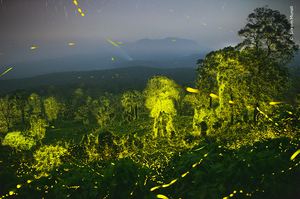
If you're looking for a breath of fresh air, we have just the thing: the newly-crowned winners of the Wildlife Photographer of the Year competition.
The London Museum of History, which runs the prestigious contest, revealed the winning images at a ceremony on Tuesday. It said an international panel of expert judges chose the 19 category winners out of 49,957 entries from 95 countries, based on their originality, narrative, technical excellence, and ethical practice.
The images take us underwater, deep into the woods and high above cities. They come from different parts of the world and tell the stories of various species. But they all showcase the diversity — and precarity — of life on Earth.
"Whilst inspiring absolute awe and wonder, this year's winning images present compelling evidence of our impact on nature – both positive and negative," said Doug Gurr, the director of the Natural History Museum. "Global promises must shift to action to turn the tide on nature's decline."
That's especially true of the two grand title winners.

French marine biologist and underwater photographer Laurent Ballesta was awarded Wildlife Photographer of the Year for his "otherworldly" image of a tri-spine horseshoe crab accompanied by three golden trevallies.
This is actually his second win, which contest organizers say is unprecedented. He took home the grand title in 2021 for his images of mating camouflage groupers in French Polynesia. Both portfolios focused on endangered species in protected waters.
Tri-spine horseshoe crabs have survived for more than 100 million years. Fossil evidence from Lebanon shows they were scuttling through warm waters at the same time dinosaurs roamed the land and skies.
But they are now under threat from habitat destruction and overfishing, with hundreds of thousands of horseshoe crabs harvested annually to be used both as bait for other species and for scientific research. Their blue blood is used in the development of vaccines — though that could soon start to change.
Ballesta documented the species as they feed, mate and thrive in the protected waters of Pangatalan Island in the Philippines. The Natural History museum said the images took the judges by surprise.
"To see a horseshoe crab so vibrantly alive in its natural habitat, in such a hauntingly beautiful way, was astonishing," said jury chair Kathy Moran. "We are looking at an ancient species, highly endangered, and also critical to human health. This photo is luminescent."

The Young Wildlife Photographer of the Year award went to 17-year-old Carmel Bechler of Israel for his dynamic shot of barn owls in an abandoned roadside building. He used natural light and long exposure times to capture the light from passing traffic.
Bechler said his work aims to show that "the beauty of the natural world is all around us, even in places where we least expect it to be, we just need to open our eyes and our minds."
To the judges, the contrast between the neon lights and nesting owls highlights a growing tension between humans and wildlife.
"It simultaneously screams 'habitat destruction' and 'adaptation,' begging the question: If wildlife can adapt to our environment, why can't we respect theirs?" Moran said.
The other winning shots raise similar questions.

Karine Aigner of the U.S. won the photojournalist story award for her portfolio focused on hunting competitions in Texas, for example. Overhead views of a polluted river in Indonesia and bulldozed land in Mexico serve as stark reminders of the impact humans are having on their own environment.
All of the images will be on display as part of an exhibit at London Natural History Museum that opens Friday. It will tour across the U.K. and to other countries including Australia, Canada, France, New Zealand and Singapore before it closes in late June 2024.
Then it will be nearly time to award a whole new batch of winners. The historic 60th edition of the competition will be accepting submissions starting Monday and until early December.
In the meantime, check out a sampling of this year's winners:









Wildlife Photographer of the Year is developed and produced by the Natural History Museum in London.







